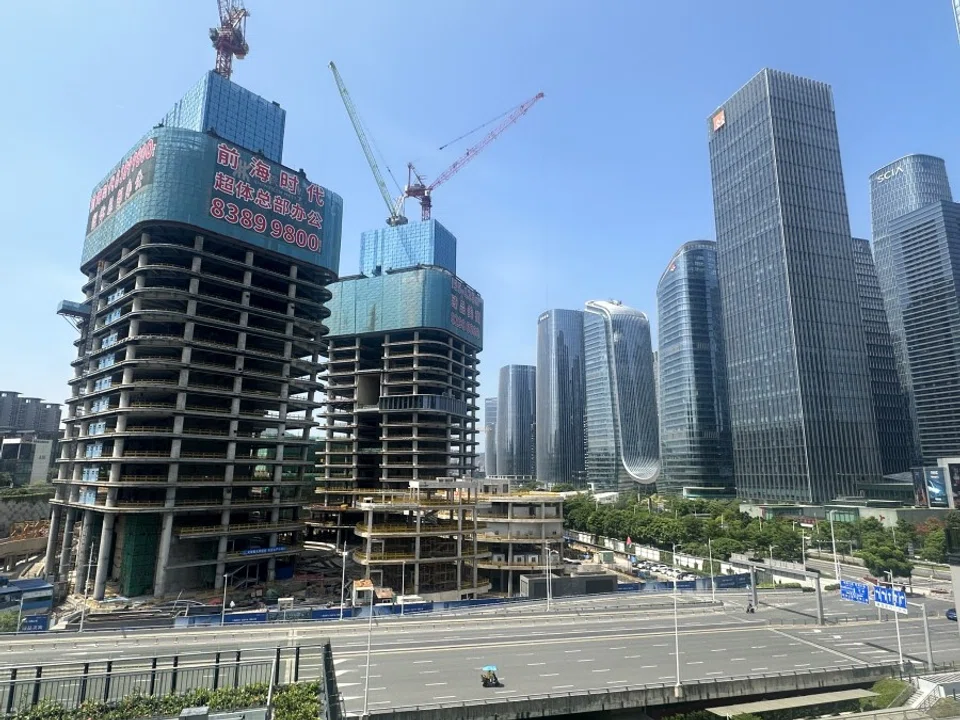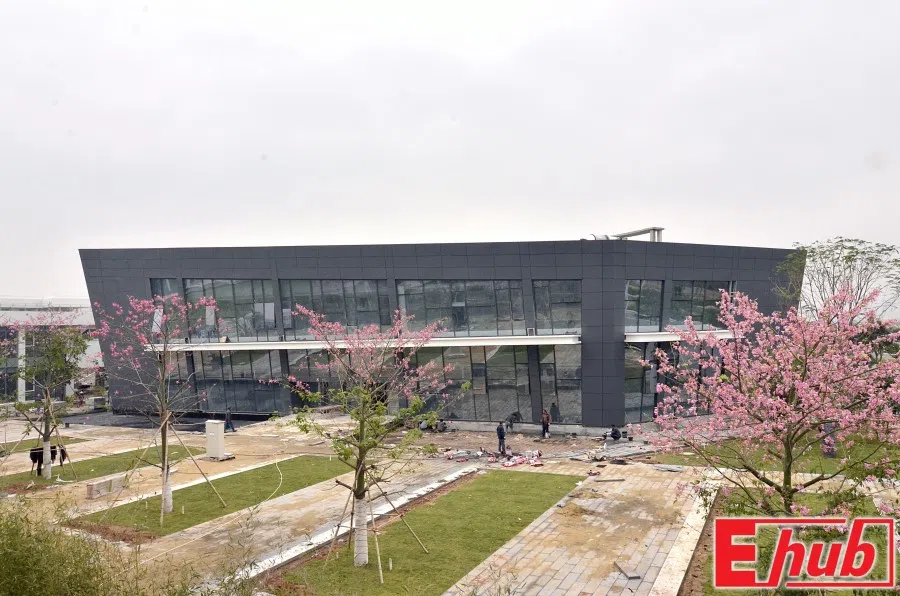Shenzhen's deserted business district needs more pull to develop
Shenzhen's Qianhai is a relatively new business district that the Chinese government wants to develop. However, there has been comparatively little pull so far, given that general facilities are lacking and the supportive policies for foreign companies are no different from those in other areas in Shenzhen. However, some business people Zaobao talked to are upbeat about its future.

China has been developing Shenzhen's Qianhai as a key business district in recent years. However, many companies are only registering their address in Qianhai to enjoy policy benefits without having an actual physical presence there, and those that have rented office spaces have not yet started operations - the low foot traffic has made this area, known as a "special zone within a special zone", seemingly deserted.
Companies' presence only on paper
Due to its geographical proximity to Hong Kong, the Qianhai Shenzhen-Hong Kong Modern Service Industry Cooperation Zone, located in western Shenzhen, Guangdong province, was established to promote modern service industries and technological innovation between Guangdong and Hong Kong through systemic innovation.
Since the launch of the initiative in 2010, its preferential policies have attracted a large number of high-tech, financial and service industry enterprises. As of the end of 2022, there are over 100,000 registered enterprises in the Qianhai Sanwan area (comprising Mawan, Qianwan and Guiwan areas).
However, human traffic has not reflected this growth. During a recent visit to Qianhai, I found most areas quiet, even on regular workdays, except for Guiwan where there were relatively more people. The business parks were quiet, with several empty lots still up for rent, while the occupied offices were locked up with no employees in sight.
... the vacancy rate for Grade A office buildings in Qianhai hit 30.1% as of the first quarter of 2023, the highest among the business districts in Shenzhen.

Liu, who works in the finance industry in Qianhai, told Lianhe Zaobao that nearly half of the office spaces in his building are vacant, while employees are not even going to those that their companies have rented.
The overall vacancy rate in the Shenzhen office building market has remained high over the past three years. According to data released by Jones Lang LaSalle (JLL), the vacancy rate for Grade A office buildings in Qianhai hit 30.1% as of the first quarter of 2023, the highest among the business districts in Shenzhen.
Li Wenjie, director of JLL's Shenzhen Commercial Real Estate Department, said that as an emerging business district, Qianhai saw most of its office buildings completed and delivered after 2019, so a higher vacancy rate is expected. Over the past three years, the pandemic has hampered the movement of people between mainland China and Hong Kong, and in turn, impacted Qianhai's overall development to some extent.
Due to the initial shortage of office spaces in Qianhai, the authorities allowed companies to register their addresses in the area without the need to have a physical office. With the gradual completion of office buildings, the Qianhai Administration Bureau proposed the "Return to Nest" (企业归巢) action plan in 2018, offering subsidies to companies that take up the physical office spaces.
Qianhai's current high vacancy is mainly due to the insufficient number of companies returning to physical office spaces.
Not enough companies returning
An academic in Shenzhen who declined to be named said that Qianhai's current high vacancy is mainly due to the insufficient number of companies returning to physical office spaces. Many industries, especially the service industry, are just taking advantage of the policy benefits that come with registering their addresses in Qianhai.

He remarked that the establishment of a new business district relies on industry support, but Qianhai's urban functions still need to be improved, and there is a lack of industry and talent aggregation. "Qianhai undoubtedly has the potential to become a top-notch business district in China, surpassing those in many other countries, but that will still take years of development to stand the test of time," he added.
In 2021, the Chinese central government announced an approximately eightfold increase in Qianhai's total area, expanding it from 14.92 square kilometres to 120.56 square kilometres, to promote the area's reform and opening up.
Yinuo Tang, an assistant professor of strategy and international business with HSBC Business School at Peking University, said that Qianhai's sudden expansion would make the area appear relatively empty as the people would be more spread out. However, he believes that this is a temporary phenomenon. Qianhai's prospects are good, and more people will choose to work and live there as its financial, legal and patent systems gradually mature and the supporting facilities are improved.
He said, "There is no fixed location for Shenzhen's central area, and it has been moving westward from Luohu to Futian, Nanshan, and now Qianhai. But this movement may still take some time."
... while Qianhai's development is still in its infancy, it is a fertile land for young entrepreneurs given the strong atmosphere of innovation. - Tian Yuanrui, executive director of agricultural system R&D company Shenzhen Qianhai Shennong Future Technology

Lower entry threshold gives more space to grow
While human traffic in Qianhai is relatively low, some companies believe that it is precisely the right environment for them to set up business and operations.
You, who is in charge of Shenzhen Shengyang Optical Technology, said that it is mainly companies in the finance and technological innovation industries that are currently in Qianhai, and the quiet environment is more favourable than having high human traffic as it allows the employees to concentrate on their work.
Tian Yuanrui, executive director of agricultural system R&D company Shenzhen Qianhai Shennong Future Technology (深圳前海神农未来科技公司), said that while Qianhai's development is still in its infancy, it is a fertile land for young entrepreneurs given the strong atmosphere of innovation. In 2014, the Qianhai Administration Bureau set up the Qianhai Shengang-Hong Kong Youth Innovation and Entrepreneur Hub as a base for entrepreneurship for Shenzhen and Hong Kong youths.
... more foreign companies will gradually want to leverage these advantages and develop in Qianhai. - Low Boon Tian, executive chair of the Singapore Chamber of Commerce and Industry in China in South China

Singaporean businessman Dennis Goh, who has investment projects in Qianhai, believes that the area provides an opportunity for market reshuffling, and the lower entry threshold gives new companies more space to grow. He noted that companies in Qianhai can expand faster as the area is well connected to the Guangdong-Hong Kong-Macao Greater Bay Area, which has a complete industrial chain of R&D, manufacturing and sales.
He Jin, founder of Shenzhen Hongda Business Services, said that with the resumption of movement of people between Shenzhen and Hong Kong, Hong Kong companies are showing an increasing interest in investing in Qianhai. However, most preferential policies primarily target Hong Kong companies, so foreign companies are not showing particularly strong investment interest in Qianhai.
Low Boon Tian, executive chair of the Singapore Chamber of Commerce and Industry in China in South China, also said that there isn't a strong incentive for companies to relocate as the supporting facilities in Qianhai are lacking and the preferential policies for foreign companies are no different from those in other parts of Shenzhen.
However, considering the policy support in Qianhai for talent and institutional innovation, as well as the upcoming connectivity between Qianhai and the Greater Bay Area, Low believes that more foreign companies will gradually want to leverage these advantages and develop in Qianhai.
This article was first published in Lianhe Zaobao as "深圳"特区中的特区"显冷清 专家:优势仍在前景乐观".





